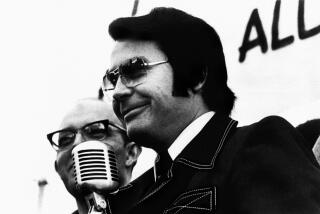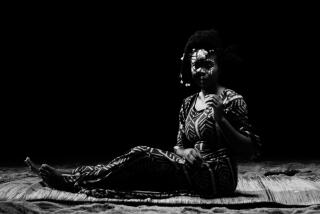Three Brazilian Films Deal With African Religious Roots
- Share via
The California Afro-American Museum in Exposition Park commences a free monthly Sunday series of Afro-Brazilian films at noon with Nelson Periera dos Santos’ “The Amulet of Ogum” (1975). All three films Sunday touch upon the African roots of Afro-Brazilian religion. Vera de Figueiredo’s “Creation of the World: A Samba Opera” (1985) screens at 2:15, followed an hour later by Walter Lima Jr.’s “Chico Rei” (1986). The series is being presented in conjunction with the exhibition, “Introspectives: Contemporary Art by Americans and Brazilians of African Descent.”
“The Amulet of Ogum” is not one of the father of Cinema Novo’s best films, but it fits well into the series. Tending to ramble even more than most Brazilian pictures, it’s a volatile mixture of violence and voodoo. A fable told by a blind troubadour to three would-be attackers in the dark alleys of a Rio suburb, it celebrates the rituals of condomble , a mixture of the ancient African Yoruba religion and Catholic beliefs, and tells of the adventures of a young man, charmed at birth to be impervious to all physical injury, who becomes king of the underworld in Rio’s slums.
A Variety reviewer called “Creation of the World: A Samba Opera” a “front-row seat to the Carnival,” but it is much more than that. De Figueiredo cuts from the dazzling parade of the samba schools, a highlight of Rio’s famous annual celebration, to allow the dancers to act out in song and dance an ancient fertility rite, clearly of African origin, in a series of outdoor settings both rural and urban. It centers on the mating of the Yoruba goddess Odudua and the male god Obatala, which results in the creation of life. This is an infectious, highly sensual film featuring scores of stunning-looking people in costumes of the utmost splendor and elegance--lacy, befeathered and bespangled silver-and-white dominates. The participants are all working-class people, apparently without formal training in singing and dancing, but they are kings and queens for a day in finery that would strike envy in the heart of the producer of a Broadway musical (or a Vegas revue). Yet amid all the glitter there emerges a spirit of joy and laughter--and never the crassness of hard-edged show business.
Filmed in 1979 and 1980 but held up for exhibition until three years ago, “Chico Rei” is a remarkable saga of spiritual survival in the face of the extreme and enduring hardships of slavery. It commences in the 18th Century with as harrowing a re-enactment of the horrors of the slave ship as one could imagine and moves on to a picturesque colonial town nestled in the mountains of the Minas Gerais province. Ironically, it’s a Shangri-la setting for the terrible suffering of the slaves whose wives were sent off to Bahia while they are put to laboring in the gold mines, often castrated in the belief that this somehow would make them better workers.
In this sprawling fresco of a film its central figure gradually emerges. He is the slaves’ king back in the Congo, Galanga (Severo D’Acelino), a tall, imposing man now known as Chico Rei who continues to be his people’s spiritual leader even in chains. With power and imagination Lima, a colleague of the late Glauber Rocha, depicts the transformation of man into myth. In the process we discover how the slaves were sustained by their music--they were allowed drums--and by preserving their African gods and beliefs by concealing and melding them in Catholic ritual. It’s almost needless to say that these three films boast the most wonderfully intoxicating music.
Information: (213) 744-7432.
More to Read
The biggest entertainment stories
Get our big stories about Hollywood, film, television, music, arts, culture and more right in your inbox as soon as they publish.
You may occasionally receive promotional content from the Los Angeles Times.










